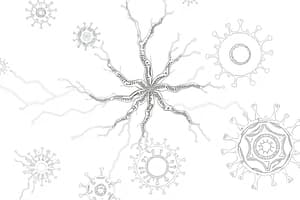Podcast
Questions and Answers
What type of immune cells are associated with pus or suppuration?
What type of immune cells are associated with pus or suppuration?
- Lymphocytes
- Eosinophils
- Macrophages
- Neutrophils (correct)
What is the typical timeframe for chronic inflammation?
What is the typical timeframe for chronic inflammation?
- Days to weeks
- Years to decades
- Months to years
- Weeks to months or years (correct)
What is a characteristic feature of chronic inflammation?
What is a characteristic feature of chronic inflammation?
- Fibrosis (correct)
- Vasodilation
- Vascular changes
- Edema
What is not a characteristic feature of chronic inflammation?
What is not a characteristic feature of chronic inflammation?
What is the result of chronic inflammation?
What is the result of chronic inflammation?
What is pleurisy?
What is pleurisy?
What is the term for inflammation of lung parenchyma?
What is the term for inflammation of lung parenchyma?
What is the purpose of inflammation in the body?
What is the purpose of inflammation in the body?
What is the difference between pleurisy and pneumonia?
What is the difference between pleurisy and pneumonia?
What is the result of inflammation in the body?
What is the result of inflammation in the body?
What is the medical term for the fluid accumulation caused by inflammation?
What is the medical term for the fluid accumulation caused by inflammation?
What is one of the causes of endothelial contraction?
What is one of the causes of endothelial contraction?
What is another term for the fluid accumulation?
What is another term for the fluid accumulation?
What is the name of the chemical that causes endothelial contraction?
What is the name of the chemical that causes endothelial contraction?
What is the result of endothelial contraction?
What is the result of endothelial contraction?
What occurs when there is an extravasation of protein-rich fluid?
What occurs when there is an extravasation of protein-rich fluid?
What do leukocytes extend to attach to the extracellular matrix?
What do leukocytes extend to attach to the extracellular matrix?
What is the term for the extreme slowing of blood flow?
What is the term for the extreme slowing of blood flow?
What role do pseudopods play in leukocyte movement?
What role do pseudopods play in leukocyte movement?
What is the result of stasis?
What is the result of stasis?
What is the term for the fluid that pours into the extravascular tissues?
What is the term for the fluid that pours into the extravascular tissues?
After attaching to the extracellular matrix, what happens to the rest of the leukocyte?
After attaching to the extracellular matrix, what happens to the rest of the leukocyte?
What is the consequence of stasis on the blood vessels?
What is the consequence of stasis on the blood vessels?
What is the purpose of leukocytes extending pseudopods?
What is the purpose of leukocytes extending pseudopods?
What is the result of leukocytes extending pseudopods and attaching to the extracellular matrix?
What is the result of leukocytes extending pseudopods and attaching to the extracellular matrix?
Flashcards are hidden until you start studying
Study Notes
Inflammation
- Inflammation is a protective response to tissue damage or infection
- Characterized by the pouring of protein-rich fluid (exudate) into extravascular tissues
Types of Inflammation
- Pleurisy: Inflammation of the pleura (membranes surrounding the lungs)
- Pneumonia: Inflammation of lung parenchyma (lung tissue)
Phases of Inflammation
- Acute: PMN's (Neutrophils), Pus/suppuration
- Chronic: Weeks to months or years, characterized by fibrosis (scarring) and no vascular changes
Mechanisms of Inflammation
- Stasis: Extreme slowing of blood flow leading to fluid accumulation and inflammatory oedema (swelling)
- Causes of stasis:
- Endothelial contraction caused by histamine, bradykinin, and leukotrienes
- Leukocytes extending pseudopods to attach to the extracellular matrix and pulling the remainder of the cell after
Studying That Suits You
Use AI to generate personalized quizzes and flashcards to suit your learning preferences.




